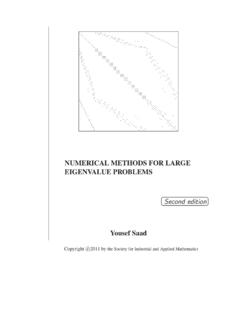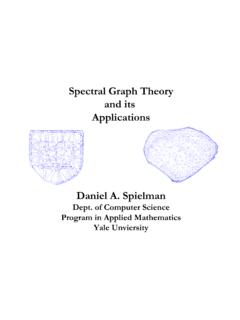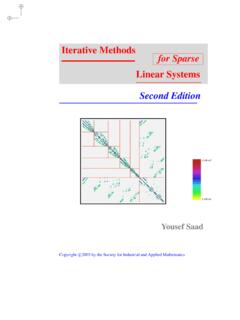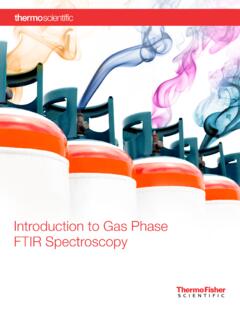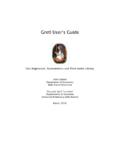Transcription of Chapter 7 84 Introduction To Remote Sensing
1 84 Practical Work in GeographyChapter 7 Introduction To RemoteSensingYou have read about aerial photography in Chapter 6. If you havecarefully gone through its contents, you would have appreciatedthat it is an extension of the observation and recording capabilitiesof the human eyes. You may also have noticed that the photographicsystem utilises the same principles of observation and recording theobjects of the earth s surface, as being done by the eyes. However,both the human eyes and the photographic systems respond to lightin a minute portion of the total energy received and responded bythe objects surface. The present day Remote Sensing devices, on theother hand, react to much wider range of radiations reflected/emitted,absorbed and transmitted by all object surfaces at a temperature above0 Kelvin (-273 C).The term Remote Sensing was first used in the early 1960s. Later,it was defined as the total processes used to acquire and measure theinformation of some property of objects and phenomena by arecording device (sensor) that is not in physical contact with theobjects and phenomena in study.
2 It can be noted from the abovedefinition of Remote Sensing that it primarily involves an objectsurface, the recording device and the information carrying energywaves (Fig ).NATURAL SENSOROBJECT SURFACEI nformationCarryingEnergy WavesFigure Conceptual Frame of Remote Sensing NCERTnot to be republished85 Introduction To Remote SensingGlossaryAbsorptance : The ratio of the radiant energy absorbed by a substance to the energyit : The specific wavelength interval in the electromagnetic image : An array of digital numbers (DN) arranged in rows and columns,having the property of an intensity value and their Number : An intensity value of a pixel in a digital Image Processing : The numerical manipulation of DN values for the purposeof extracting information about the phenomena of the surface they Radiation (EMR) : The Energy propagated through a space or amedium at a speed of Spectrum.
3 The continuum of EMR that ranges from short wavehigh frequency cosmic radiations to long wavelength low frequency radio Colour Composite (FCC) : An artificially generated colour image in whichblue, green and red colours are assigned to the wavelength regions to which they donot belong in nature. For example, in standard a False Colour Composite blue isassigned to green radiations ( to m), green is assigned to red radiations ( m and red is assigned to Near Infrared radiation ( to m).Gray scale : A medium to calibrate the variations in the brightness of an image thatranges from black to white with intermediate grey : The permanent record of a scene comprising of natural and man-madefeatures and activities, produced by photographic and non photographic : The ground area covered by an image or a : Any imaging or non imaging device that receives EMR and converts it intoa signal that can be recorded and displayed as photographic or digital : The ratio of the radiant energy reflected by a substance to the energyit Band : The range of the wavelengths in the continuous spectrum such asthe green band ranges from to.)
4 6 and the range of NIR band to . NCERTnot to be republished86 Practical Work in GeographySTAGES IN Remote SENSINGF igure illustrates the processes used in Remote Sensing dataacquisition. These basic processes that help in the collection of informationabout the properties of the objects and phenomena of the earth surfaceare as follows :(a) Source of Energy (sun/self-emission);(b) Transmission of energy from the source to the surface of the earth;(c) Interaction of energy with the earth s surface;(d) Propagation of reflected/emitted energy through atmosphere;(e) Detection of the reflected/emitted energy by the sensor;(f) Conversion of energy received into photographic/digital form ofdata;(g) Extraction of the information contents from the data products; and(h) Conversion of information into Map/Tabular Stages in Remote Sensing Data Acquisitiona. Source of Energy: Sun is the most important source of energyused in Remote Sensing .
5 The energy may also be artificially generatedand used to collect information about the objects and phenomena suchas flashguns or energy beams used in radar (radio detection and ranging).b. Transmission of Energy from the Source to the Surfaceof the Earth: The energy that emanates from a source propagatesbetween the source and the object surface in the form of the waves of NCERTnot to be republished87 Introduction To Remote Sensingenergy at a speed of light (300,000 km per second). Such energypropagation is called the Electromagnetic Radiation (EMR). The energywaves vary in size and frequency. The plotting of such variations is knownas the Electromagnetic Spectrum (Fig. ). On the basis of the size of thewaves and frequency, the energy waves are grouped into Gamma, X rays, Ultraviolet rays, Visible rays, Infrared rays , Microwaves and Radiowaves. Each one of these broad regions of spectrum is used in differentapplications.
6 However, the visible, infrared and microwave regions of energyare used in Remote Interaction of Energy with the Earth s Surface: Thepropagating energy finally interacts with the objects of the surface of theearth. This leads to absorption, transmission, reflection or emission of energyfrom the objects. We all know that all objects vary in their composition,appearance forms and other properties. Hence, the objects responses to theenergy they receive are also not uniform. Besides, one particular object alsoresponds differently to the energy it receives in different regions of thespectrum (Fig. ). For example, a fresh water body absorbs more energyin the red and infrared regions of the spectrum and appears dark/black ina satellite image whereas turbid water body reflects more in blue and greenregions of spectrum and appears in light tone (Fig. ).Figure Electromagnetic Spectrum NCERTnot to be republished88 Practical Work in Geographyd.
7 Propagation of Reflected/Emitted Energy throughAtmosphere: When energy is reflected from objects of the earth ssurface, it re enters into the atmosphere. You may be aware of the factthat atmosphere comprises of gases, water molecules and dust energy reflected from the objects comes in contact with the atmosphericconstituents and the properties of the original energy get modified. Whereasthe Carbon dioxide (CO2), the Hydrogen (H), and the water moleculesabsorb energy in the middle infrared region, the dust particles scatter theblue energy. Hence, the energy that is either absorbed or scattered bythe atmospheric constituents never reaches to sensor placed onboard asatellite and the properties of the objects carried by such energy wavesare left IRS 1 C Band 1 Green (Left) and Band 4 IR Images ofSambhar Lake, RajasthanFigure spectral Signature of Soil, Vegetation and Water NCERTnot to be republished89 Introduction To Remote Sensinge.
8 Detection of Reflected/Emitted Energy by the Sensor:The sensors recording the energy that they receive are placed in a near polar sun synchronous orbit at an altitude of 700 900 km. Thesesatellites are known as Remote Sensing satellites ( Indian RemoteSensing Series). As against these satellites, the weather monitoring andtelecommunication satellites are placed in a Geostationary position (thesatellite is always positioned over its orbit that synchronises with thedirection of the rotation of the earth) and revolves around the earth(coinciding with the direction of the movement of the earth over its axis) atan altitude of nearly 36,000 km ( INSAT series of satellites). Acomparison between the Remote Sensing and weather monitoring satellitesis given in Box ( ). Figure shows the orbits of Sun-Synchronousand Geostationary satellites Sensing satellites are deployed with sensors which are capableof collecting the EMR reflected by the objects.
9 We have seen in Chapter 6 Box. Comparison between Sun-Synchronous and Geostationary SatellitesOrbitalSun SynchronousGeostationaryCharacteristicsS atellitesSatellitesAltitude700 900 km@ 36,000 kmCoverage810 N to 810 S1/3rd of the GlobeOrbital period@ 14 orbits per day24 hoursResolutionFineCoarse(182 metre to 1 metre)(1 km x 1 km)UsesEarth ResourcesTelecommunicationApplicationsan d Weather monitoringFigure Orbit of Sun Synchronous (Left) and Geostationary (Right) Satellites NCERTnot to be republished90 Practical Work in Geographyhow the photographic camera obtains photographs at an instance ofexposure. However, the sensors used in Remote Sensing satellites possessa mechanism that is different from photographic camera in collecting andrecording the information. The images so acquired by space-borne sensorsare in digital format as against the photographic format obtained througha camera-based Conversion of Energy Received into Photographic/Digital Form of Data: The radiations received by the sensor areelectronically converted into a digital image.
10 It comprises digital numbersthat are arranged in rows and columns. These numbers may also beconverted into an analogue (picture) form of data product. The sensoronboard an earth-orbiting satellite electronically transmits the collectedimage data to an Earth Receiving Station located in different parts of theworld. In India, one such station is located at Shadnagar near Extraction of Information Contents from DataProducts: After the image data is received at the earth station, it isprocessed for elimination of errors caused during image data the image is corrected, information extraction is carried out fromdigital images using digital image processing techniques and fromanalogue form of data products by applying visual interpretation Conversion of Information into Map/Tabular Forms:The interpreted information is finally delineated and converted into differentlayers of thematic maps. Besides, quantitative measures are also taken togenerate a tabular sensor is a device that gathers electromagnetic radiations, converts itinto a signal and presents it in a form suitable for obtaining informationabout the objects under investigation.













